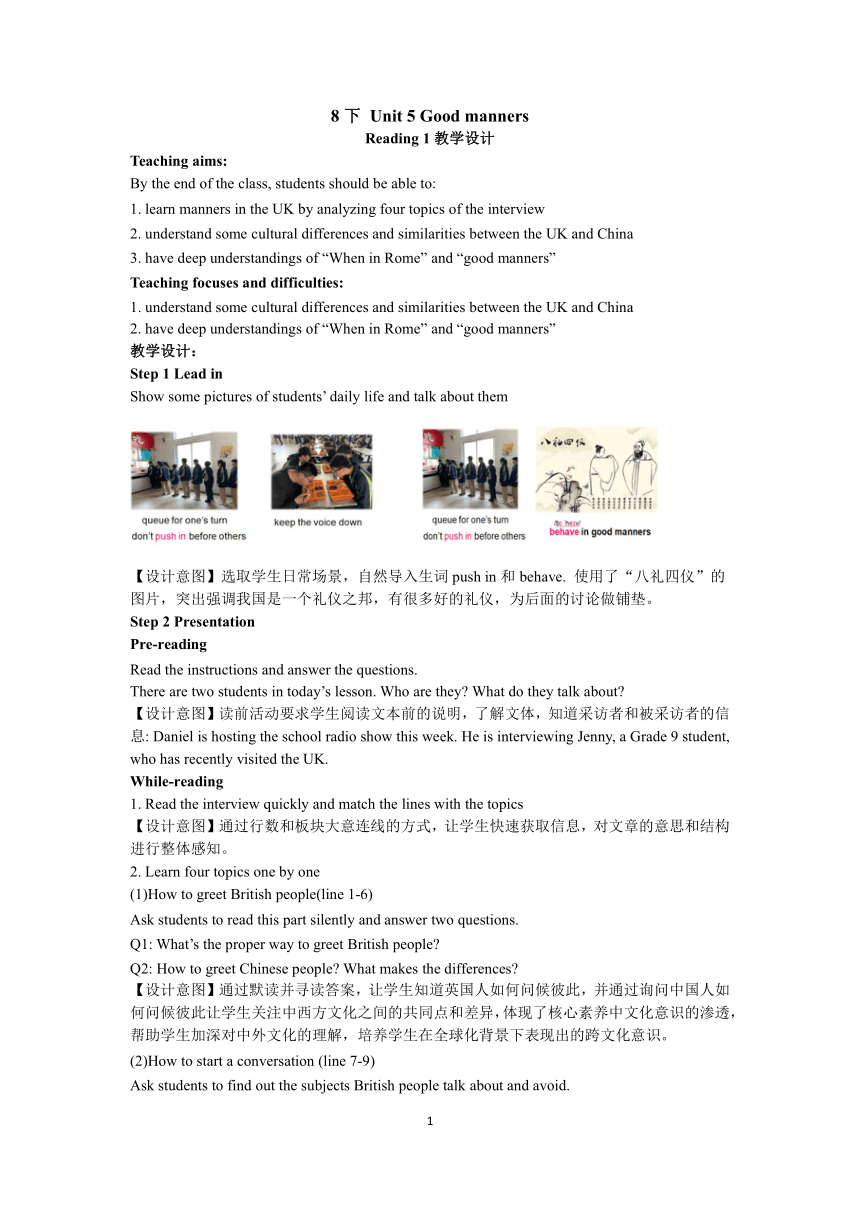牛津译林版八年级下册 Unit 5 Good manners Reading 1 教案
文档属性
| 名称 | 牛津译林版八年级下册 Unit 5 Good manners Reading 1 教案 |

|
|
| 格式 | docx | ||
| 文件大小 | 578.7KB | ||
| 资源类型 | 教案 | ||
| 版本资源 | 牛津译林版 | ||
| 科目 | 英语 | ||
| 更新时间 | 2023-06-02 14:32:02 | ||
图片预览

文档简介
8下 Unit 5 Good manners
Reading 1教学设计
Teaching aims:
By the end of the class, students should be able to:
1. learn manners in the UK by analyzing four topics of the interview
2. understand some cultural differences and similarities between the UK and China
3. have deep understandings of “When in Rome” and “good manners”
Teaching focuses and difficulties:
1. understand some cultural differences and similarities between the UK and China
2. have deep understandings of “When in Rome” and “good manners”
教学设计:
Step 1 Lead in
Show some pictures of students’ daily life and talk about them
【设计意图】选取学生日常场景,自然导入生词push in和behave. 使用了“八礼四仪”的图片,突出强调我国是一个礼仪之邦,有很多好的礼仪,为后面的讨论做铺垫。
Step 2 Presentation
Pre-reading
Read the instructions and answer the questions.
There are two students in today’s lesson. Who are they What do they talk about
【设计意图】读前活动要求学生阅读文本前的说明,了解文体,知道采访者和被采访者的信息: Daniel is hosting the school radio show this week. He is interviewing Jenny, a Grade 9 student, who has recently visited the UK.
While-reading
1. Read the interview quickly and match the lines with the topics
【设计意图】通过行数和板块大意连线的方式,让学生快速获取信息,对文章的意思和结构进行整体感知。
2. Learn four topics one by one
(1)How to greet British people(line 1-6)
Ask students to read this part silently and answer two questions.
Q1: What’s the proper way to greet British people
Q2: How to greet Chinese people What makes the differences
【设计意图】通过默读并寻读答案,让学生知道英国人如何问候彼此,并通过询问中国人如何问候彼此让学生关注中西方文化之间的共同点和差异,体现了核心素养中文化意识的渗透,帮助学生加深对中外文化的理解,培养学生在全球化背景下表现出的跨文化意识。
(2)How to start a conversation (line 7-9)
Ask students to find out the subjects British people talk about and avoid.
Further thinking 1: Give some other examples about “something else”. (group discussion)
Further thinking 2: Which subject is talked mostly Guess why
Do Chinese people avoid subjects like these
【设计意图】阅读第一课时要让学生通过关注字里行间理解文意,通过小组讨论的方式对 “something else”和“weather”进行探究和学习;设计不同层级的问题(两个further thinking)让学生对于Good manners有更全面的认识:即好的礼仪不仅体现在尊重国家之间的不同,也体现在日常交流中选择不同的话题。
(3)How to behave in public (line 10-17&20-22)
Ask students to fill in a table.
Show students a short video about how British people behave in public
【设计意图】用表格的形式检测学生对于文本的理解,表格中有一处视频的超链接,为使观看视频更有效,笔者针对视频内容先设置了问题,引起学生的兴趣后,再让他们观看视频,充分利用试听资源。
(4)How to behave at home (line 18-19)
Read together and anwer the questions.
Q1: What do British people say at home
Q2: Do we need to say “please” and “thank you” at home
Summary: There is a saying goes “Civility costs nothing”.
【设计意图】本环节进行中西方文化差异的呈现,学生进行不同的思维碰撞,各抒己见。从British manners中引发对daily manners的思考,体现用教材教的理念,最后用谚语“礼多人不怪”进行总结,本单元的study skills学习的是谚语,体现了单元整体备课的思路。
Post reading
1. Ask students to discuss about the following pictures:
What will you do in the occasions
How do you understand “good manners”
【设计意图】本环节旨在要求学生对文本和标题有更深入地理解,标题When in Rome并不是在讨论罗马这个国家,而是谚语“When in Rome, do as the Romans do”的缩写;经过讨论,让学生对“good manners”中的“good”有更深入的理解:“good”并不仅仅是指好的,更是指合适的。这一环节旨在培养学生further and critical thinking的能力。
2. Ask students to work in groups of 4 and one student chooses one topic. Give advice to teacher’s friend Amy.
【设计意图】教师创设情境:教师的一位朋友Amy暑假将要去英国旅行,请同学们根据所学课文从四个方面给Amy提出建议,旨在让学生整体回顾文本,运用所学知识和句型。
Step 3 Homework
1. Read the passage aloud after the tape twice after listening to it.
2. Find more about manners in different countries on the Internet if you are interested in.
5
Reading 1教学设计
Teaching aims:
By the end of the class, students should be able to:
1. learn manners in the UK by analyzing four topics of the interview
2. understand some cultural differences and similarities between the UK and China
3. have deep understandings of “When in Rome” and “good manners”
Teaching focuses and difficulties:
1. understand some cultural differences and similarities between the UK and China
2. have deep understandings of “When in Rome” and “good manners”
教学设计:
Step 1 Lead in
Show some pictures of students’ daily life and talk about them
【设计意图】选取学生日常场景,自然导入生词push in和behave. 使用了“八礼四仪”的图片,突出强调我国是一个礼仪之邦,有很多好的礼仪,为后面的讨论做铺垫。
Step 2 Presentation
Pre-reading
Read the instructions and answer the questions.
There are two students in today’s lesson. Who are they What do they talk about
【设计意图】读前活动要求学生阅读文本前的说明,了解文体,知道采访者和被采访者的信息: Daniel is hosting the school radio show this week. He is interviewing Jenny, a Grade 9 student, who has recently visited the UK.
While-reading
1. Read the interview quickly and match the lines with the topics
【设计意图】通过行数和板块大意连线的方式,让学生快速获取信息,对文章的意思和结构进行整体感知。
2. Learn four topics one by one
(1)How to greet British people(line 1-6)
Ask students to read this part silently and answer two questions.
Q1: What’s the proper way to greet British people
Q2: How to greet Chinese people What makes the differences
【设计意图】通过默读并寻读答案,让学生知道英国人如何问候彼此,并通过询问中国人如何问候彼此让学生关注中西方文化之间的共同点和差异,体现了核心素养中文化意识的渗透,帮助学生加深对中外文化的理解,培养学生在全球化背景下表现出的跨文化意识。
(2)How to start a conversation (line 7-9)
Ask students to find out the subjects British people talk about and avoid.
Further thinking 1: Give some other examples about “something else”. (group discussion)
Further thinking 2: Which subject is talked mostly Guess why
Do Chinese people avoid subjects like these
【设计意图】阅读第一课时要让学生通过关注字里行间理解文意,通过小组讨论的方式对 “something else”和“weather”进行探究和学习;设计不同层级的问题(两个further thinking)让学生对于Good manners有更全面的认识:即好的礼仪不仅体现在尊重国家之间的不同,也体现在日常交流中选择不同的话题。
(3)How to behave in public (line 10-17&20-22)
Ask students to fill in a table.
Show students a short video about how British people behave in public
【设计意图】用表格的形式检测学生对于文本的理解,表格中有一处视频的超链接,为使观看视频更有效,笔者针对视频内容先设置了问题,引起学生的兴趣后,再让他们观看视频,充分利用试听资源。
(4)How to behave at home (line 18-19)
Read together and anwer the questions.
Q1: What do British people say at home
Q2: Do we need to say “please” and “thank you” at home
Summary: There is a saying goes “Civility costs nothing”.
【设计意图】本环节进行中西方文化差异的呈现,学生进行不同的思维碰撞,各抒己见。从British manners中引发对daily manners的思考,体现用教材教的理念,最后用谚语“礼多人不怪”进行总结,本单元的study skills学习的是谚语,体现了单元整体备课的思路。
Post reading
1. Ask students to discuss about the following pictures:
What will you do in the occasions
How do you understand “good manners”
【设计意图】本环节旨在要求学生对文本和标题有更深入地理解,标题When in Rome并不是在讨论罗马这个国家,而是谚语“When in Rome, do as the Romans do”的缩写;经过讨论,让学生对“good manners”中的“good”有更深入的理解:“good”并不仅仅是指好的,更是指合适的。这一环节旨在培养学生further and critical thinking的能力。
2. Ask students to work in groups of 4 and one student chooses one topic. Give advice to teacher’s friend Amy.
【设计意图】教师创设情境:教师的一位朋友Amy暑假将要去英国旅行,请同学们根据所学课文从四个方面给Amy提出建议,旨在让学生整体回顾文本,运用所学知识和句型。
Step 3 Homework
1. Read the passage aloud after the tape twice after listening to it.
2. Find more about manners in different countries on the Internet if you are interested in.
5
